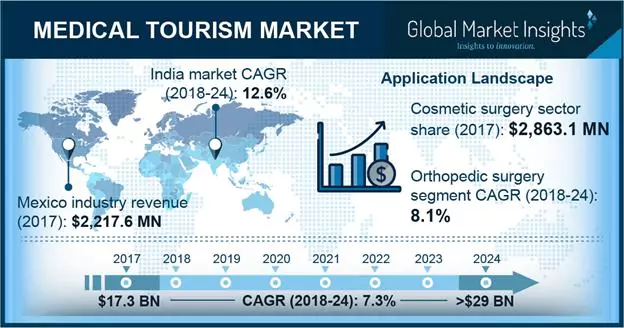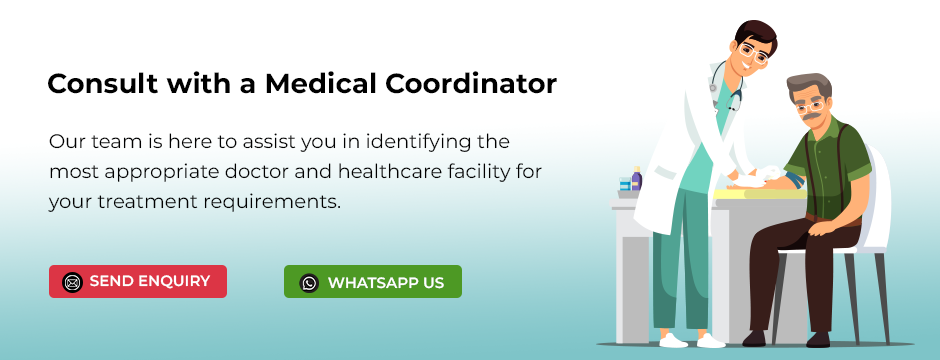
On account of arrivals of foreign medical tourists in 2027, the India medical tourism market is predicted to produce US$ 35.12 billion, up from US$ 5.63 billion in 2021.
Since the Vedic era, India has had a long and distinguished medical history. Ayurveda, one of the earliest medical systems, was developed around 8000 BCE. Since achieving independence, India's progress in modern medicine has accelerated; it has created a distinctive atmosphere for holistic health that combines the best in modern healthcare, alternative medicine, and wellness.
India is therefore regarded as one of the top destinations for medical tourism as a result of the interaction of this distinctive holistic health and wellness ecosystem and its many opportunities.

From 2021 to 2027, the India medical tourism market is anticipated to grow at a CAGR of 35.68%.
The main objective of the Indian health sector is to promote India as a rising medical destination for people all over the world, enabling them to utilize the nation's medical expertise and infrastructure.
Additionally, India provides fairly priced access to high-quality healthcare and medical services. Ayurveda centers are increasingly common in hotels and resorts. Nowadays, the majority of international tourists solely travel to India for Ayurvedic treatments. In order to promote health tourism around the world, prominent tour operators have included Ayurveda in their brochures.
Kerala, one of the southern Indian states, has established health tourism as one of its products to market Kerala as a tourist destination. Another stated differentiator for the state is health tourism.
The study discovered that important nations including Bangladesh, Iraq, the Maldives, Afghanistan, Oman, Yemen, Sudan, Kenya, and Nigeria send medical tourists to India. Additionally, we think India has a big chance to identify and go after medical tourists from other parts of the world, like Europe and the Americas.
Quality and other parts of the healthcare services provided must be retained to remain competitive against nations like Thailand, South Korea, Singapore, and Dubai, which can only be done by enforcing strict regulations. With major cities like Delhi, Mumbai, Chennai, Bangalore, Hyderabad, and Kolkata, India is one of the most sought-after locations for medical tourism due to its well-known medical expertise.
A report indicates that 27% of all medical tourists who entered India in November came to Maharashtra, 15% came to Chennai, and 5-7% came to Kerala. Some of the biggest markets for medical tourism in India are the SAARC region, the Middle East, Southeast Asia, and Africa. More than half of all medical visitors to India come from Bangladesh. Foreign visitors to India are no longer required to get a medical visa in order to receive treatment, with the exception of organ transplants, according to a statement from the Union Home Ministry.
The government's decision to remove the two-month waiting period for Gulf travelers is anticipated to boost the market for medical travel to India. The official language of India is English, which is spoken by the majority of its citizens. Additionally, almost all medical workers speak English. A few hospitals in Noida have translators on staff to help patients from the Balkans and Africa feel more comfortable while receiving medical care.

People from various Western countries travel abroad for medical care as medical tourists, according to current trends in the industry. The most common procedures people cited that they traveled for were a host of complex, specialized procedures like breast augmentations, bariatric surgeries, dermabrasion, and angioplasty surgeries. People generally pay about 30% of what they would in the Western world traveling abroad for a similar procedure. IVF treatment in the US can cost $12,000 or more, and many IVF treatments are often needed to make them successful. Many also travel seeking other elective treatments like LASIK eye surgeries or dental procedures that are not covered under Western country insurance plans, yet are exceptionally expensive in some Western countries.
Around the world, "health cities" like Chennai, Bangkok, Kuala Lumpur, or Sao Paolo are booming due to private sector health care. These hospitals provide a wide range of treatments under one roof and a welcoming environment to draw patients from different Western nations. India is the leader among these Southeast Asian nations that attract medical tourists because it has between 75 and 80 percent of the private sector firms and investments within its borders.
Asia as a whole is investing more and more in the medical tourism sector. Asia's top destination for medical tourists right now is India. This transformation is being pushed by improved infrastructure and better-trained medical professionals, as well as the Western world's soaring healthcare costs that are driving patients abroad for care. There are ever more places for medical tourists throughout the world.
Countries like Egypt and South Africa are taking the lead with international tourism, according to current trends in medical tourism. As more inexpensive pricing emerges all around the world, the Cayman Islands, Costa Rica, Brazil, Chile, and Ecuador are emerging as top destinations for foreign medical tourists.
Due to rising healthcare costs in many Western countries, people are increasingly traveling abroad for medical care, particularly to developing nations like Thailand, India, Singapore, and Costa Rica. From countries like Australia, New Zealand, Canada, the US, or the UK, medical tourists are dominant.
The "baby boom" generation of medical tourists is the most recent trend in this industry. This movement has already started. Optimistic parents travel abroad to receive commercial surrogacy and IVF treatments in countries like Russia or the Ukraine. The majority of Western nations forbid or refuse to carry out these treatments.

More and more diverse medical practices are opening up all over the world, pushing medical tourism to new heights as "healthcare" becomes an ever-more-diversified term. The most prevalent medical treatments and diagnostic tests are shifting to poorer nations where individuals may afford proper care with or without insurance because they have become practically unaffordable in the West.
A. The market for medical travel to India is expected to be worth $7,417 million by the end of 2022.
A. India makes up about 6.5% of the worldwide medical tourism market: The market for medical tourism in India is expanding as a result of the increase in inbound medical travel and top player’s market share is about 3%-8%.
A. The Indian Medical Tourism Market is expected to reach $35.12 billion in value by 2027, growing at a 35.6% CAGR.
A. LaMedTrip Medical Tourism India, Bumrungrad International Hospital, Samitivej Hospitals, Bangkok Hospital Group, Apollo Hospitals Enterprise Ltd., and Fortis Hospitals are a few of the major companies active in the medical tourism business.
